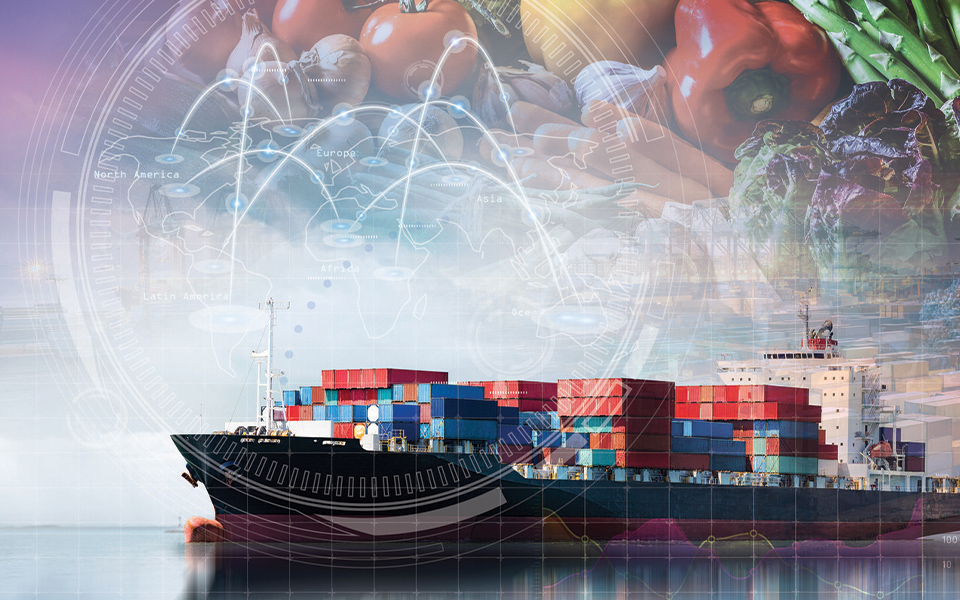*On June 1, 2023 Emerson’s Climate Technologies business became a new standalone company – Copeland. Though our name has changed, we are building on more than a century of HVACR innovation and industry leadership, and Copeland continues to offer the same products, industry stewardship, and learning opportunities you’ve grown to trust. Information found on this webpage posted before June 1, 2023 may contain our old name or branding, but you can be at ease knowing it was created with the knowledge and expertise of Copeland.
In the best of circumstances, the task of shipping perishable products is fraught with challenges. But maintaining consistent holding temperatures and following proper quality assurance processes is even more difficult when shipping goods in the global cold chain — especially when shipments cross borders between countries. In a recent article for Fresh Plaza, I reviewed the leading strategies for addressing the security risks of shipping perishable goods in the global cold chain.

Unlike in-country (or domestic) perishable shipments, transporting (or exporting) goods across borders introduces a variety of new considerations, quality concerns and potential safety hazards. Every country has its own border and/or customs procedures and food safety regulations. In addition, international shipments rely on multiple modes of transportation — including land, air and sea— and can last from days to weeks and even months. These extended cold chain journeys often pass through higher-risk zones or unfamiliar regions that can make shipments more prone to delays, theft, tampering and associated complications.
Growers, producers, shippers, third-party logistics providers and retailers all play key roles in protecting perishables throughout the global cold chain. With consumer safety, customer satisfaction and brand reputations on the line, some of the greatest potential risks to perishables include:
- Temperature excursions — which can increase the potential for food quality and safety issues, lead to product degradation, and shorten shelf lives
- Rejected shipments and late deliveries — which can result in complex disputes, missed service level agreements (SLAs) and lost business
- Shipment tampering or theft — which can lead to a complete loss of product and its associated opportunity costs, including production, shipping and sales
Minimizing the frequency and severity of these issues should be goals shared by all stakeholders, as each presents a potential threat to profitability. As global experts in cold chain shipping, Copeland (formerly Emerson’s Climate Technologies business) has developed a suite of tools, services and industry best practices to help global stakeholders monitor and secure cross-border shipments.
Maintain on-time deliveries.
Meeting promised delivery schedules is especially important for cross-border, international shipments with lengthy cold chain journeys. On-time deliveries are necessary not only for meeting customer SLAs, but also for staying within the optimal quality and/or safety lifespan of the perishable product. Even if temperatures are kept at proper setpoints, perishables may begin to deteriorate if held past their planned delivery date.
On-time delivery challenges can be mitigated by providing real-time visibility to the in-transit shipment location and temperature status. A connected cargo tracking and location monitoring infrastructure — consisting of Copeland’s GO real-time 4G/5G trackers and Oversight cargo services software— can provide stakeholders with live mapping dashboards and real-time alerts to help them maintain awareness of shipper location and temperature conditions.
Ensure cargo security.
The potential for shipping container contamination or theft can increase during cross-border shipments, especially in regions that cross paths with an illicit drug trade. Refrigerated shipping containers provide an opportunistic means for smugglers to transport drugs across the border, which can potentially compromise, contaminate or destroy an entire load. High-value shipments of perishable goods can also be tempting targets for thieves, where entire trucks can be stolen and resold on the black market.
Stakeholders need a security infrastructure capable of producing alerts when shipper doors have been opened unexpectedly. GO real-time trackers with light sensors can be used to detect doors opening or unauthorized access. Live dashboards allow stakeholders to participate in the security process by contacting authorities in the event of theft and helping them find and apprehend thieves. In addition, Oversight software can establish geofences around specific regions and alert stakeholders when shipments are entering or exiting dangerous territories.
To learn more about how Oversight cargo services can help you address cross-border challenges, please visit our website.

8 proven strategies for rigorous cold chain management
Preparing for the approval and safe use of A2Ls in commercial refrigeration applications...
Protection for high-value shipments just got even better
We’re excited to announce the release of Copeland’s newest real-time tracker, the GO Real-Time...

Three proven strategies to prevent cargo theft
The over-the-road (OTR) transport industry is experiencing a surge in cargo thefts. As thieves...
